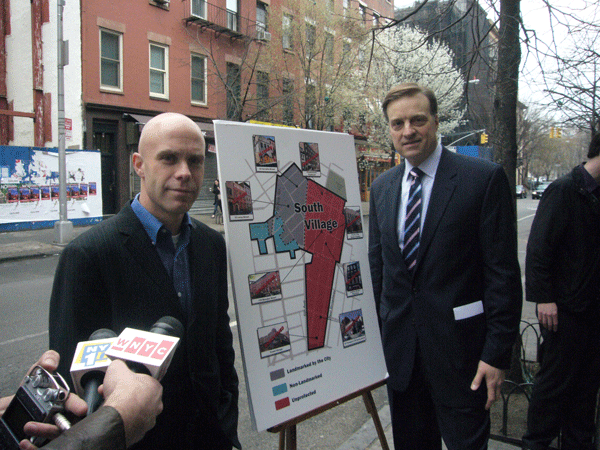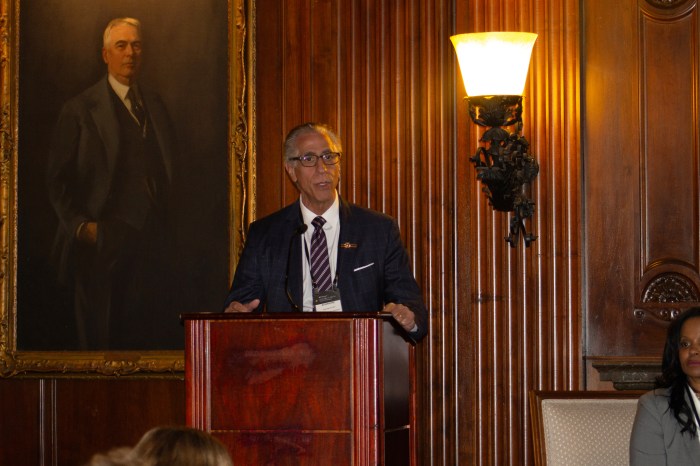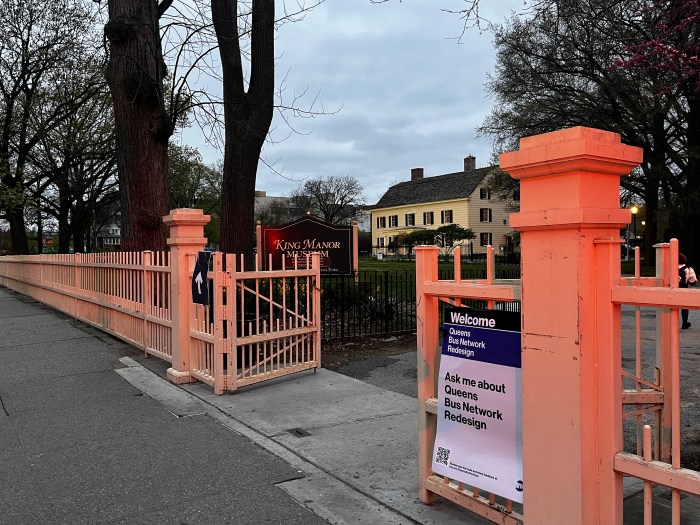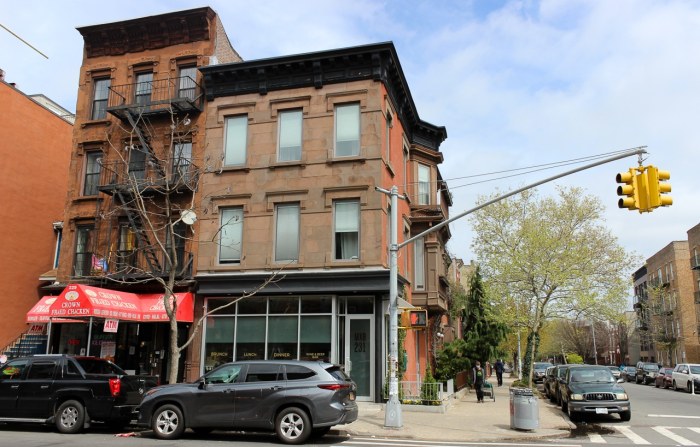BY ANDREW BERMAN | The final days of the Bloomberg administration have been a mad dash by developers and large institutions to get approvals for huge projects that will change the face of our communities forever. While neighborhood preservation advocates have been able to affect some changes for all these projects, the City Council has been extremely willing to accommodate the mayor and the developers, approving every rezoning application presented to them. Meanwhile the city has grown increasingly resistant to approving new landmark protections in our neighborhood, even those they had previously promised to do.
PRESERVATION
The 800-pound gorilla of development projects in our neighborhood was the N.Y.U. 2031 expansion plan, a massive, 2-million-square-foot development that requires handing public park space over to New York University, undoing the terms under which N.Y.U. was given public land in the 1950s and ’60s, changing residential zoning to commercial zoning, and eliminating open space preservation requirements.
The plan was first approved by Borough President Stringer on the condition that some minor tweaks be made by N.Y.U., such as moving one of its buildings a few feet farther away from some residential neighbors’ windows. The planned building was ultimately not moved, but the borough president nevertheless stood by his approvals of the plan.
The Bloomberg-controlled City Planning Commission also approved the university’s mega-plan, with only Public Advocate Bill de Blasio’s appointee voting no. The City Council nibbled further at the edges of the plan and then gave its final approval, unanimously, except for Brooklyn Councilmember Charles Barron.
Interestingly, one of the biggest community victories against the N.Y.U. plan took place long before it even got to these city officials’ desks. N.Y.U. originally proposed a 400-foot-tall tower — by far the tallest ever in Greenwich Village — near Bleecker St. on the open space within the Silver Towers complex, which the Greenwich Village Society for Historic Preservation and neighbors got landmarked in 2008. After an enormous outcry against the plan, including from Silver Towers architect I.M. Pei, N.Y.U. withdrew the tower proposal, eliminating the plan’s tallest, and by some measures, most conspicuous, element. Further public pressure resulted in a reduction by about 20 percent in the project’s size by the borough president, City Planning Commission and City Council. But, conversely, N.Y.U. got about 80 percent of what it asked for.
G.V.S.H.P., N.Y.U. faculty and a broad range of local and citywide groups are now suing to have the approvals overturned in court.
Jamestown Properties’ proposal to upzone and build two towers atop Chelsea Market also faced considerable pushback, and also got easy approval from the mayor’s City Planning Commission and the City Council. Here too, however, the most dramatic changes took place before the proposal ever got to city officials, as the developer trimmed back its ambitious plans in the face of overwhelming public opposition.
Jamestown originally proposed a huge, spaceship-like office tower to be added atop the 10th Ave. end of the historic Chelsea Market complex (overlooking the High Line park), and an ungainly hotel structure to be added to the Ninth Ave. end. After a huge public outcry, the developer reduced the size and height of the 10th Ave. office tower, and made the design less outlandish and a bit more contextual to the existing building.
Similarly, Jamestown eliminated the hotel use from the proposed Ninth Ave. tower, which had two beneficial effects — the traffic-generating hotel was removed from the plan, and the proposed replacement office tower was, unlike the hotel tower, no taller than the highest point of the existing Chelsea Market complex and more in context with its design.
Though these changes may have made the Chelsea Market upzoning plan “less bad,” they didn’t make it right, and community groups from Chelsea and the Village continued to strongly oppose it. In spite of this, the City Planning Commission unanimously voted to approve, and the City Council approved with just a few abstentions.
However, Speaker Quinn did claim to have conditioned the Council’s approval on several “givebacks” to the community and several “guarantees” that elements of Chelsea Market that the public enjoyed would remain in place “in perpetuity.”
One was the ground-level market. Advocates had pointed out that international developer Jamestown Properties, which had acquired Chelsea Market and was seeking the upzoning, had been replacing the beloved independent food shops that had made Chelsea Market such an initial success with chain clothing and other stores. So when Quinn approved Jamestown’s requested upzoning, allowing it to build two large and enormously profitable office towers atop the complex, she announced that her approval also required that 75 percent of Chelsea Market’s ground floor remain non-chain food stores in perpetuity, which would keep the character of the market at Chelsea Market as is forever.
Unfortunately, upon investigation it turned out this claim was not true. Nothing in the approvals included any prohibitions on chain stores or any requirement that food stores occupy Chelsea Market. In fact, under the agreement’s terms, Chelsea Market’s ground floor could be occupied by The Gap and a Kmart without any penalty. Several of the other promises of community amenities also turned out not to be included in the agreements governing the rezoning, and thus Jamestown would suffer no penalty, and lose none of the valuable zoning changes granted to it, if these promises are not delivered.
Speaking of promises not delivered, the city’s Landmarks Preservation Commission refused to deliver on promised landmark designations in the Far West and South Village. In 2004, the L.P.C. had promised to landmark eight individual sites in the Far West Village, along with expanding the Greenwich Village Historic District and designating a Weehawken St. Historic District. All were supposed to be done within a year.
The district extension and the new district were both designated, as were five of the promised individual designations (albeit many years behind schedule). However, three of the sites were never landmarked, and the L.P.C. finally admitted it had no intention to landmark them, including an 1830s house where the owner was seeking to build atop the historic structure (which sparked the push to get the city to finally fulfill its landmarking promise).
A broader lapse, however, was the proposed South Village Historic District, an area that Villagers have sought to landmark for nearly 50 years, and which L.P.C. Chairperson Robert Tierney promised four years ago he would consider in its entirety for designation. While a little less than 30 percent of the proposed district’s area was landmarked in 2010, Tierney promised that consideration of the remainder of the proposed district would closely follow. Several years later now, the L.P.C. has given every indication that it has no intention of moving ahead with the promised landmark designation in the foreseeable future.
To add insult to injury, while the city has refused to fulfill its promise on South Village landmarking, the mayor and the City Council have approved deeply unpopular upzoning plans that will vastly increase development pressure on either side of the South Village. N.Y.U.’s massive project directly abuts the South Village on its east, while the proposed Hudson Square rezoning borders the South Village on its south and west.
By the city’s own accounting, if the Hudson Square rezoning is approved without landmark protections, the South Village will suffer a “significant adverse impact.” And yet the administration still refuses to follow through on its landmarking promise.
The rezoning plan will only take effect, however, if it is approved by the City Council — a decision that will largely be made by Council Speaker Quinn, who represents the area. Thus the fate of the South Village, and the decision as to whether or not to approve a zoning change that will accelerate its destruction, now lies in Speaker Quinn’s hands.
Berman is executive director, the Greenwich Village Society for Historic Preservation


















